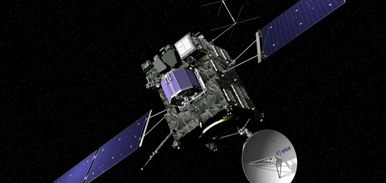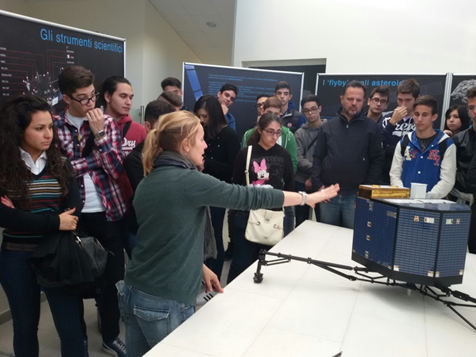The Sardinia Radio Telescope (SRT) manages to capture the signal sent by the Rosetta probe, a space mission launched by the European Space Agency (ESA) destined for comet 67P/Churyumov Gerasimenko, where exactly on November 12 of last year, it deployed the lander Philae to study its nucleus.

This significant event is part of the activities related to the space use of SRT, promoted by the Italian Space Agency (ASI), and confirms the potential of SRT in collecting data from interplanetary probes, an issue where the European Space Agency (ESA) and the American Space Agency (NASA) are constantly seeking support stations, given the enormous flow of data collected by the probes.
Thanks to the availability of the modern and advanced research and development laboratories of the INAF – Astronomical Observatory of Cagliari (OAC), funded by the Sardinia Region, it was possible to carry out in just a few weeks a significant “restoration” of a microwave receiver operating in X-band and Kα-band (8 GHz and 30 GHz respectively) previously used at the INAF radio telescope in Noto, Sicily.
Additionally, SRT has recently been equipped with a high-resolution digital spectrometer based on “ROACH” boards and new generation FPGA devices, developed in Cagliari as part of an international collaboration called “CASPER.”
The development of this instrument is the core of a “Tender” Project funded by the Sardinia Region, involving INAF – OAC and the Department of Electrical and Electronic Engineering (DIEE) of the University of Cagliari.
For the President of INAF, Nichi D’Amico, “The SRT radio telescope, besides being a cutting-edge tool of modern radio astronomy, has great potential in various space applications where Sardinia can play a leading role, and to which the European Community is paying great attention: for example, monitoring space debris and asteroids potentially on a collision course with Earth, an issue that concerns planetary-level safety and the enhancement of the network of antennas that can operate in receiving data sent by interplanetary probes, like Rosetta.”
“The activities are of extreme interest to DASS” (the Aerospace District of Sardinia, ed.), D’Amico also recalls, on which the Region is currently placing great attention.
“The news of the successful reception of data from the Rosetta probe by the Sardinia Radio Telescope is a source of great satisfaction for ASI,” says the President of the Italian Space Agency, Roberto Battiston. “SRT is not only one of the most advanced radio telescopes in the world but also an extraordinary tool for “dialogue” with interplanetary probes: this is highlighted by the interest that both ESA and NASA have shown towards its use, thanks to ASI, of this exceptional instrument. Discussions regarding agreements with both NASA and ESA have already begun, and I am sure others will follow. Today we have taken an important step towards the future of solar system exploration.”
The activities in question, promoted by Roberto Ambrosini, one of Italy’s leading experts in “Space Science,” have been carried out by a good part of the SRT Operational Team, in collaboration with the team from the INAF Radio Astronomy Institute in Bologna, led by Tonino Pisanu, a Technologist at INAF who coordinates the advanced Technological laboratories of the new Selargius site, and Alberto Pellizzoni, an Astronomer who oversaw the writing of the observational schedules and the astronomical characterization of the receiver. In particular, Giuseppe Valente and Pasqualino Marongiu, respectively responsible for the microwave laboratory and the mechanics laboratory, contributed to the installation and use of the receiver, Enrico Urru, an electronic engineer and fellow, who personally took charge of the receiver’s restoration, Marco Buttu, Raimondo Concu, Elise Egron, Francesco Gaudiomonte, Noemi Iacolina, Adelaide Ladu, Andrea Melis, Pierluigi Ortu, Mauro Pili, Sergio Poppi, Andrea Saba, Giampaolo Serra, and Gian Paolo Vargiu.
The SRT Operational Team is coordinated by Ettore Carretti, the new Station Manager. Ettore spent more than five years in Australia, where he directed the prestigious Parkes radio telescope, one of the most popular in the world, and has recently returned to Italy as part of the “Brain Gain” Program, choosing the INAF site in Cagliari and assuming the role of SRT Station Manager.
The important reception of the signal emitted by Rosetta occurs during a special week for the Astronomical Observatory of Cagliari: indeed, on the occasion of the celebrations of the International Year of Light and the first week of public opening of the new Selargius site (event ASTRinLUCE), the OAC is hosting the Rosetta mission exhibition, designed and created by ASI, including explanatory panels and scale models of Rosetta and Philae.
The exhibition, inaugurated with a conference for schools by Dr. Mario Salatti, co-project manager of Philae, will be open to the public throughout November on dates and times available on the Astronomical Observatory of Cagliari’s website.
